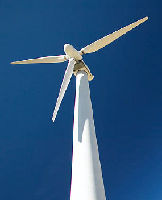Fossil & Renewable Energy Supplies
Petroleum based products - eg plastics
Link to alternative products (in lifestyle?)
Renewable Energy
Renewable energy resources do not:
- Cause acid rain
- Add to the greenhouse effect
- Deplete world resource forever!
The disadvantages of many renewable sources are that they can be difficult to exploit and are only suitable for electricity generation.They are also not without their own impact on the environment.
Globally there is a very low level of renewable energy production. Hydro-electric is the most significant and produces 6% of the world's primary energy and 20% of the world's electricity. Developing countries use more local energy sources. 50% of the world's population use very little oil, gas or electricity.
| Renewable Energy Certificates: are a representation of the amount of energy generated from renewble sources. Each certificate represents 1MegaWatt of renewable energy generated. These certificates are used to comply with both voluntary and mandatory markets for renewables and are used by power companies, or sold into voluntary markets as a way of meeting commitments to customers and governments without having to make a physical transfer of renewable energy electrons into a seperate grid.
The state of the world for renewable energy includes:
95 countries now obtain electricity from the wind
15,000 homes worldwide are powered by solar cells
90% of Cyprus homes have solar panels.
By 1986, half the fuel used in cars in Brazil was ethanol - produced from sugar cane.
|
|
 |
| 
